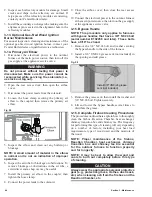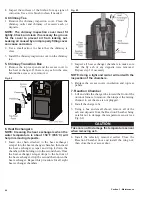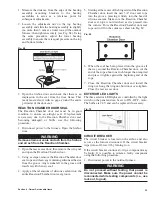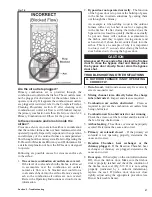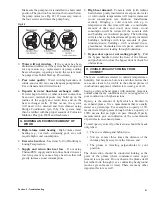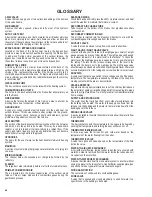
60
10. Supply and return lines uninsulated - Uninsulated
supply and return lines in areas that are not intended
to be heated (unheated crawl spaces, under mobile
homes, etc.) may cause excessive heat loss. Insulate
the supply and return lines.
12. Poor water quality - Water with high amounts of
solids, sand or dirt can create deposits inside the
wall of heat exchanger components, reducing the
amount of heat output. If this condition is suspected,
contact your Central Boiler dealer.
13. New construction with radiant in-floor heat -
Bringing a cold concrete slab up to temperature the
first time will take a considerable amount of time
and wood; once warm, wood consumption will
be reduced if the concrete slab and building are
insulated properly.
14. Heat load too large - Re-evaluate the system and
match heat load to the outdoor furnace.
D. SMOKE COMING FROM BETWEEN
FIREBOX DOOR AND FRONT OF THE
DOOR FRAME
1. Door seal faulty or door frame obstructed - If there
is smoke coming from between the firebox door and
the front of the door frame for more than a short time
after reloading, scrape the face and surface area of
the door frame to remove any deposits. Check the
condition of the firebox door seal and replace if
necessary.
E. OUTDOOR FURNACE IS OVERHEATING
1. Air entering through the firebox door or smoke
coming out of the firebox door when the door
is closed - Make sure the firebox door is properly
latched and check the condition of the firebox door
seal (Fig. 80). If it is not sealing properly (indicated
by a uniform indentation), replace the seal. If
firebox door does not close tightly, adjust using
the appropriate procedure (see Owner Serviceable
Items).
Fig. 80
NOTE: If the outdoor furnace is operated with the
door open, the firebox door seal will melt.
2. Solenoid and/or air regulating disc stuck
open or obstructed - Remove any obstructions.
Lubricate with WD-40 or similar type of lubricant.
If replacement is necessary, refer to Fig. 72 for the
factory settings for the air regulating discs.
NOTE: If the outdoor furnace loses water from
boiling, the problem should be identified and
repaired immediately. Under normal operation,
little or no water needs to be added. Adding
water to the furnace may cause corrosion if not
immediately treated with Corrosion Inhibitor
Plus™ to the proper pH and nitrite levels. In
addition, the amount of dissolved solids in the
system (due to adding additional water) can
cause problems.
3. Water is not circulating - Check to make sure
the pump is operating and water is circulating
continuously through the supply and return lines
to keep water temperature uniform in the outdoor
furnace.
4. Circulation valve(s) closed - Be sure the proper
valves in the system are open to allow circulation.
5. Pulse set to run too long and/or too often in a low
heat draw situation - Increase the time between
idle pulses of air and/or decrease the amount of
time the pulse is provided (see FireStar operating
instructions).
5. FireStar controller set incorrectly - Refer to
FireStar operating instructions.
F. FREQUENT PUMP TROUBLE OR POOR
WATER CIRCULATION
1. Pump mounted incorrectly - If the pump is not
mounted on the outdoor furnace, it must be mounted
at a minimum of four feet lower than the top water
level in the outdoor furnace (see Fig. 81).
Fig. 81
Section 5 - Troubleshooting
Summary of Contents for e-Classic 1450 IR
Page 17: ...15 Section 1 Outdoor Furnace Installation...
Page 29: ...27 Section 1 Outdoor Furnace Installation Fig 30 Fig 31...
Page 30: ...28 Section 1 Outdoor Furnace Installation Fig 32 Fig 33...
Page 66: ...64 E CLASSIC 1450 WIRING DIAGRAM Section 6 General Information...
Page 67: ...65 Section 6 General Information E CLASSIC 1450 WIRING DIAGRAM OPTIONAL POWER IGNITION...
Page 69: ...67 NOTES...
Page 70: ...68 NOTES...
Page 71: ...69 NOTES...

